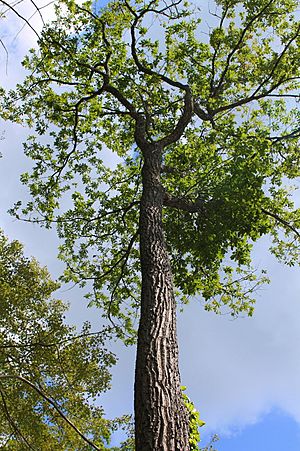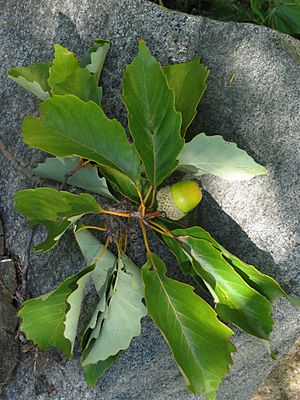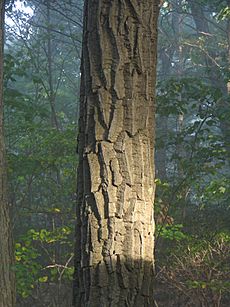Chestnut oak facts for kids
Quick facts for kids Chestnut oak |
|
|---|---|
 |
|
| Chestnut oak in Weiser State Forest | |
| Conservation status | |
| Scientific classification | |
| Genus: |
Quercus
|
| Species: |
montana
|
 |
|
| Natural range | |
| Synonyms | |
|
|
The chestnut oak (scientific name: Quercus montana) is a type of oak tree. It belongs to the group of "white oaks." You can find it growing naturally in the eastern United States. It's a very important tree on the tops of ridges, from southern Maine all the way to central Mississippi. There's even a small group of them in southern Michigan.
People sometimes call it the rock oak. This is because it often grows in rocky, mountain-like places. Chestnut oaks are usually not super tall, often around 18 to 22 meters (about 60-72 feet) high. But if they grow in really good spots, they can get much taller, sometimes up to 40-43 meters (about 130-140 feet)! A young chestnut oak, about 10 years old, will be around 5 meters (16 feet) tall if it gets lots of sunshine.
Contents
What's in a Name?
For a long time, there was some confusion about the name of the chestnut oak. It was often mixed up with another tree called the swamp chestnut oak (Quercus michauxii). Some scientists even thought they were the same tree!
The name Quercus prinus was used for both trees. But now, scientists agree that Quercus montana is the correct name for the chestnut oak. The word montana in its scientific name is Latin for "mountains" or "coming from mountains." This makes sense because these trees often grow in rocky, hilly areas.
How to Spot a Chestnut Oak
The easiest way to tell a chestnut oak apart is by its bark. It has very thick, dark gray-brown bark with deep ridges. It's actually the thickest bark of any oak tree in eastern North America!
Its leaves are about 12 to 20 centimeters (5-8 inches) long and 6 to 10 centimeters (2-4 inches) wide. They have 10-15 rounded bumps (lobes) along their edges. These leaves look a lot like those of the swamp chestnut oak or the chinkapin oak. But you can still tell the trees apart by their bark. Chinkapin oak bark is lighter gray and peels a bit, while swamp chestnut oak bark is paler and scaly. Also, chinkapin oaks have much smaller acorns.
Another way to tell them apart is by where they grow. If you see an oak with this bark on a dry ridge, it's probably a chestnut oak. If it's in a wet, low area, it's more likely a swamp chestnut oak. But remember, this isn't always a perfect rule!
Here are some cool facts about chestnut oaks:
- Bark: It's dark and has deep cracks that form wide ridges. Young branches start out bronze-green, then turn reddish-brown, and finally dark gray. This bark is full of something called tannic acid.
- Wood: The wood is dark brown with lighter sapwood. It's heavy, hard, strong, and lasts a long time, especially when it touches the soil. People use it for fences, firewood, and railway ties.
- Winter Buds: The buds in winter are light chestnut brown and shaped like an oval with a pointed tip.
- Leaves: The leaves grow one after another along the stem. They are about 12 to 23 centimeters (5-9 inches) long and 7 to 11 centimeters (3-4.5 inches) wide. They have rounded or pointed teeth along the edges. When they first grow, they are yellow-green or bronze and shiny. As they get older, they become thick, firm, and dark yellow-green on top, with a paler green and fuzzy underside. In autumn, they turn a dull yellow and then yellow-brown.
- Flowers: Chestnut oaks bloom in May, when their leaves are about one-third grown. They have two types of flowers: male flowers that hang in long, fuzzy strings called catkins, and female flowers that grow in short clusters.
- Acorns: These trees produce acorns every year, either alone or in pairs. The acorns are bright chestnut brown and shiny. They are about 3 to 4 centimeters (1.25-1.5 inches) long. The cup that holds the acorn covers about one-half or one-third of it. The inside of the acorn is white and tastes a little sweet.
The acorns of the chestnut oak are some of the biggest among native North American oaks. Only the bur oak has bigger acorns!
Its Role in Nature
Chestnut oaks are very common trees on the tops of ridges in the eastern hardwood forests. If a young chestnut oak is cut down, it can easily grow back from its stump. Many chestnut oaks in the Appalachian Mountains grew back this way after being logged. These trees can live for a long time and produce good quality wood when they grow well. Their large acorns are also a great food source for many wild animals.
How People Use Chestnut Oaks
Chestnut oak trees are not always the best for getting lumber because they often branch out low and aren't very straight. But when they grow in good conditions, their wood is very useful. It's sold as 'mixed white oak' timber.
In the past, the bark of the chestnut oak was very important. It has a lot of tannin, which was used a lot in the leather tanning industry. This is how they made animal hides into leather. However, the wood itself was often thrown away because people thought it wasn't as good as white oak wood.
By the late 1800s, there weren't as many mature white oaks left. So, loggers started using chestnut oak wood more. It can be used for many of the same things as white oak wood. Since it resists rot well, it's also used for fences, railway ties, and other things that touch the soil. Because its wood is quite dense (heavy), chestnut oak also makes excellent firewood.
You can even eat the acorns from chestnut oaks! But if they taste bitter, you might need to soak them in water to remove some of the tannins first.
Images for kids
See also
 In Spanish: Roble castaño para niños
In Spanish: Roble castaño para niños





